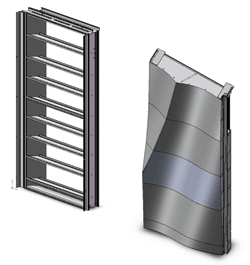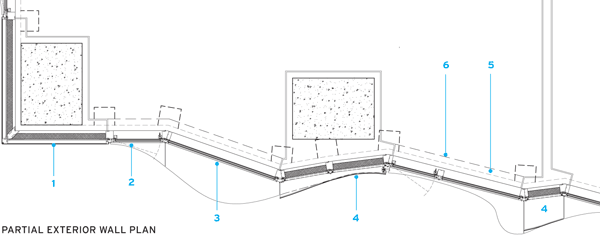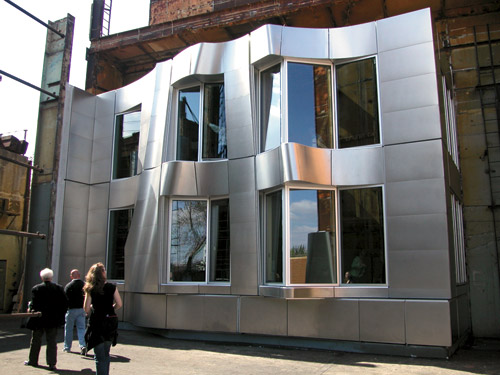Behind the Curtain Wall
Computer models of the T-shaped tower were created by scanning physical models, a process that produced point clouds of scalable data. Designers used Rhino software to do preliminary surfacing of the building, but once those forms were refined, the team switched to Digital Project, an offshoot of Catia, Dassault Systèmes' aerospace and automotive design program, which GT developed to be a more user-friendly platform for the architecture and engineering community. "No other platform out there could have made Beekman Tower," says Terry Bell, GP's project partner. "It is the only one that has the ability to analyze surfaces in a sophisticated way that can be tied to parametrics and script writing."
 |
Beekman Tower's curving, 16-gauge stainless-steel face sheets are riveted to an aluminum rain screen subframe which were then attached to the flat, unitized curtain-wall panels in the shop. The assembly is hung from the cast-in-place concrete floor slab at aluminum embeds along the slab edge. |
This was especially crucial as the tower's design began to go through several iterations. Since work on the project began in 2003, the shifting economy caused dramatic changes in program, and even threatened to cut the building in half. "That was devastating for a while to contemplate," Gehry recalls.
The switch from condominiums to a building composed entirely of rental units caused significant disruption to the facade because of adjusted floor-to-floor heights and smaller room sizes. "Whenever a unit changes, everything shifts on the surface," explains GT's Dennis Shelden. "The flow of the metal is different."
The digitized physical surface allowed the designers the flexibility to tweak the facade yet still remain within established parameters. For instance, the rain-screen panels can curve out as much as 6 feet; the minimum projection is 6 inches. Throughout the process, Permasteelisa used the revised dimensions and geometries of the 10,300 curtain-wall units to update pricing and automate production.
"We developed a naming convention with Permasteelisa for the different units," says Bell. "All the various component sizes, angles, and extrusion types could be tracked to a particular unit. They were also tied to the manufacturing process with CNC data through to fabrication and installation."
While the facade is complex, the building's concrete structure is straightforward. But because of the surface's waves, each tower floor plate is unique (a rectangular, brick-clad structure forms the building's base). Pouring the concrete slab became complicated at the slab edges, where 4-inch-deep aluminum embeds, to which the curtain-wall units are fit, needed to be precisely located. Three separate surveyors were used to verify the coordinates of the embeds.
 |
|||
|
Â
 |
The folds of the facade become bay windows for the apartments. Photo: © William Paterson |
Â
The 16-gauge stainless-steel face sheets of the rain screen were produced in Permasteelisa's factory in Grand Rapids, Michigan, while the flat curtain-wall units were fabricated in its Miami facility. Despite the complicated geometry of the facade, the shop-fabricated wall assemblies of the unitized system made installation easy and economical.
The design team says there was no cost premium for the curving facade. The tower's southern wall, by contrast, is completely flat. "That was a design choice," says Gehry. "I wanted it to slice. When you see the building in profile from the east and west it looks like someone took a rock and cut it."









